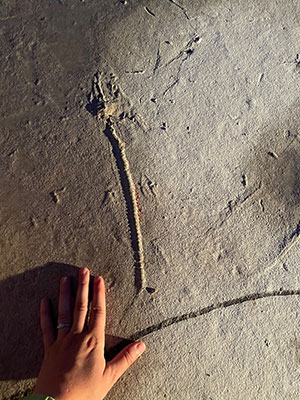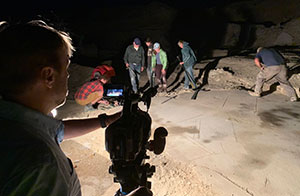UWs Vietti Leads Student Expedition into Four Kemmerer Fossil Fish Quarries
Published August 11, 2021

Laura Vietti recently took some of her students on a trip back in time to Wyoming’s Green River Formation, where Eocene-era fish once swam; bats and birds flew; and giant mammals and crocodiles roamed.
“The fossil lake sediments preserved in the Green River Formation preserve some of the best fossils in the world,” says Vietti, museum and collections manager for the University of Wyoming Geological Museum. “The unique environment of the fossil lake prevented scavenging and promoted quick burial, which led to fossils preserved in great detail including scales, feathers, insect wings, flowers and more.”
During its field trip from July 18-21, the research group, made up of Vietti and a handful of UW students, visited the Green River Stone Co. quarry, Rick Hebdon’s state fossil quarry, Fossil Safari quarry and American Fossil quarry, which are all located in and around Kemmerer.
“One of my primary goals of the field trip was to educate my students on the past Eocene lake environments and how they evolved through time,” Vietti says. “We went to several outcrops and quarries from different paleo lake depths, as well as a paleo shoreline to see how the fish species, fish preservation and rock type changed with depth. Fish fossils tend to be less intact in the shallower environments and better preserved in the deeper environments.”
The most common vertebrate fossils are fish. During its excursion, the group primarily found Knightia, Wyoming’s state fossil, named after UW’s first geologist, Wilbur Knight; and Diplomystus. Both are related to modern-day herring. Although rarer, Wyoming’s Green River Formation boasts the country’s best-preserved Eocene bats, birds, caimans, crocodiles, dragonflies, ferns, mammals, snakes and turtles.
“One quarry owner gave us a once-in-a lifetime experience by taking us on a night excavation where they wait until dark, turn on large floodlights and search for fossils in the rock using oblique light,” Vietti explains.
Fossils in the deeper lake layers are best removed if still covered by sediment so that careful preparation can be conducted in the prep lab. Bones of these specimens are not visible to the naked eye. To locate the specimens, the group looks for bumps in the rock.
“Quarry operators have found, over the decades, that the best way to find these bumps, which are usually the backbones, is by using oblique lighting at night,” Vietti says. “Subtle height changes in the rock, usually due to an underlying backbone or skull, become much more apparent under oblique lighting and cast a shadow, which otherwise would be untraceable during the day.”

Vietti’s group helped discover several large fish, which included Diplomystus, Mioplosus, Priscacara and Phareodus.
The last day of the trip, at the American Fossil quarry, provided the group a rare find -- a swimming trace fossil, which quarry owner Patrick Hogle donated to UW’s research collection.
“The trace fossil is a curved line in the rock from where the bottom tip of the tail dragged in the sediment as it was swimming, causing a curved line,” Vietti explains. “They are rare because they are very faint and, often, aren’t preserved or recognized. We hope to have it on display within the next year.”
During the trip, a producer working for Wyoming PBS joined the group and filmed the activities for a documentary called “Fossil Country.” The documentary, which is estimated to air sometime during 2022, will highlight the synergy of the fossil quarry owners, tourism, research and community, Vietti says.
The discoveries Vietti and her group made will be made available to the public next spring, when the UW Geological Museum holds its Fossil Fish Festival. The collaborative outreach event is free and open to the public, with the target audience being school kids.
“The festival highlights the Green River fossil fish by providing each visitor with their very own fossil fish specimen,” Vietti says. “And we show them how to expose or prep the fish skeleton, collected by the museum in the quarries on our fossil fish field trip, among many other interactive activities.”
UW students who participated in the field trip, listed by hometown, are:
Colorado Springs, Colo. -- Alec Wallen, a senior majoring in geology and environmental systems science.
Mantua, Ohio -- Austin Shaffer, a senior majoring in zoology and environmental systems science.
Monticello, Fla. -- Claudia Richbourg, a Ph.D. student in the Program in Ecology.
Prescott, Ariz. -- Lily Jackson, a postdoctoral researcher in geological science.
Stevens Point, Wisc. -- Will Rosenthal, a first-year Ph.D. student in the Program in Ecology.

